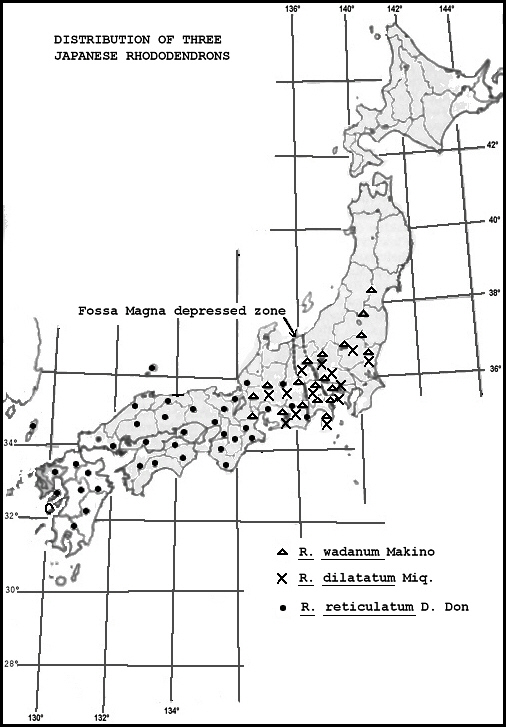QBARS - v21n1 Natural Distribution of Three Japanese Rhododendrons
Natural Distribution of Three Japanese Rhododendrons
Frank Doleshy, Seattle, Wash.
The distribution map was furnished by Professor Dr. Kankichi Sohma of the Tohoku University Biological Institute and is published with his kind permission.
Three species are charted; these are closely allied Azaleas which have been the subject of various interpretations. Some writers, possibly not familiar with these plants in native habitat, have proposed that they all be treated as phases of Rhododendron reticulatum . However, each one is recognized as a distinct species by Dr. Ohwi in his recent English-language Flora of Japan .*
* Published by the Smithsonian Institution, Washington, D.C., 1965.
I am not aware of any subsequent studies which throw further light on the classification of these species and therefore take his treatment as the standard.
In detail, Ohwi recognizes the following taxa:
- R. dilatatum Miq. (Synonym: R. reticulatum forma pentandrum Wils.), the Mitsuba-tsutsuji. Flowers purplish; nearly hairless shrub.
- R. reticulatum D. Don (Synonym: R. rhombicunt Miq.), the Koba-no-mitsubatsutsuji. Flowers rose-purple.
- R. reticulatum form albiflorum (Makino) Makino, the Shirobana-kobano-mitsuba-tsutsuji. Flowers white.
- R. reticulatum var. ciliatum Nakai, the Arage-mitsuba-tsutsuji. Hairs more persistent on branches and leaves.
- R. wadanum Makino (Synonym: R. glandulistylum Komatsu), the To-goku-mituba-tsutsuji. Flowers rose-purple; brown-hairy shrub.
Concerning their garden value, an interesting article by Mr. K. Wada appeared in the Royal Horticultural Society Rhododendron and Camellia Year Book for 1965, p. 93. He mentions that "travellers in Japan are often excited to see...well-shaped leaf-less trees beautifully covered with thousands of purple flowers', and he adds that these are the brightest of the early-flowering wild Azaleas. At the conclusion he suggests that our gardens will have more highlights if we give more affection to these neglected species.
The accompanying distribution map also shows the location of the conspicuous geological boundary called the Fossa Magna depressed zone, i.e., the "great trench". The tremendous fault scarps along the west side of this zone are the boundary which separates the Mesozoic and older rocks of southwestern Japan from the largely Tertiary rocks of northern Japan. Within the trench itself rise Mt. Fuji and other large volcanic mountains.

|
The Fossa Magna is not significant as a climatic boundary and, indeed, cuts across climatic zones. Therefore, when we find that this geological discontinuity is a boundary between plant species, we can hardly assume that the weather is a determining factor. Instead, it seems more likely that the explanation is to be found by considering such factors as the location of the ancestral stock, the rate of dispersion, (i.e., migration), or the soil differences. However, for these Azaleas, a specific explanation remains to be worked out.
Turning to the climate, it is very difficult to determine how distribution has been affected (if at all) by climatic conditions of the present age. These conditions tend to set an outer limit of distribution, but we cannot assume that the entire area within this limit is occupied by the species. Growers, however, may he interested in the following notes on climate of the areas where these plants are actually found.
Throughout this territory, continental elements tend to dominate, but the rainfall shows marine influence. Summers are generally the wettest period and are very warm, with August mean temperatures of 75°-80°F. along the coast. However, snow falls over the entire territory in winter. The area occupied by R. wadanum and R. dilatatum generally lies on the cold side of the line with a January mean temperature of 36°F.; R. reticulatum overlaps into part of this area and also extends south to much warmer areas. The northwest coast of Honshu seems to be shunned. This is an area of heavy winter precipitation, and it would seem that the plants in question dislike any of the lower hills where mean annual maximum snow cover is greater than 50-75 cm. (but they do inhabit high mountains with presumably much greater snow depths).*
* Climatic information was obtained mainly from Japan, A Geography, by Glenn T. Trewartha, The University of Wisconsin Press, Madison and Milwaukee, 1965. Those who would like further information are uged to consult this excellent English-language work.
Factors other than those mentioned may actually be more important, and Mr. Wada specifically mentions high humidity for seed germination. However, if we are merely asking these plants to grow-and do not insist that they naturalize themselves-it appears that they will find a happy home in the similar climates of eastern North America. Also, they seem to have no objection to the somewhat different climates of the Pacific Northwest.
